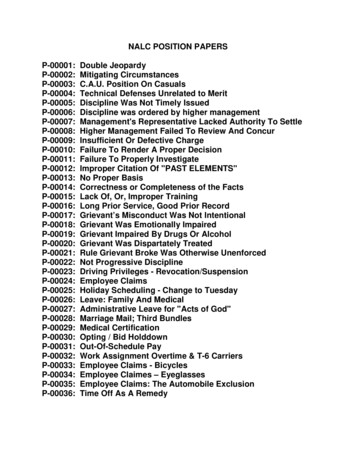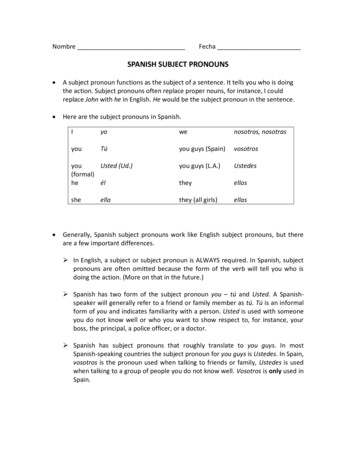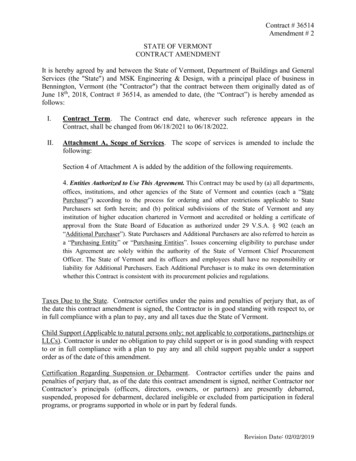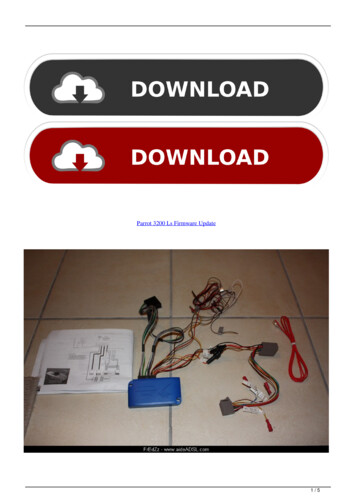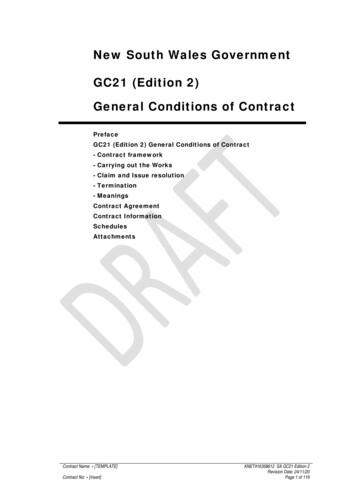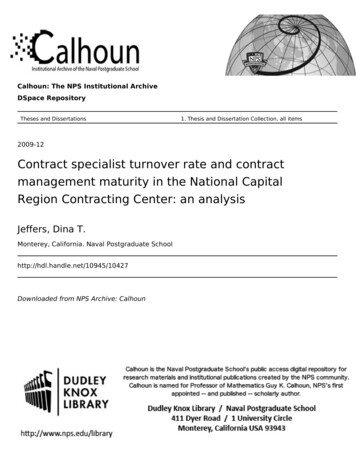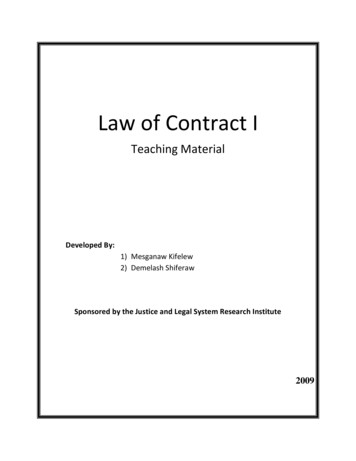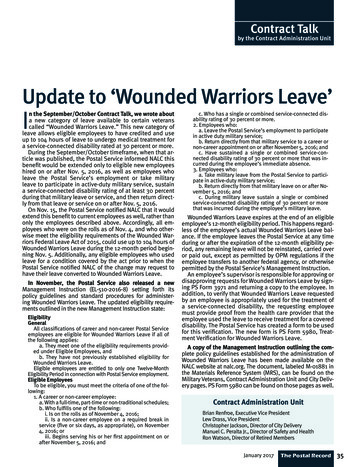
Transcription
Contract Talkby the Contract Administration UnitUpdate to ‘Wounded Warriors Leave’In the September/October Contract Talk, we wrote abouta new category of leave available to certain veteranscalled “Wounded Warriors Leave.” This new category ofleave allows eligible employees to have credited and useup to 104 hours of leave to undergo medical treatment fora service-connected disability rated at 30 percent or more.During the September/October timeframe, when that article was published, the Postal Service informed NALC thisbenefit would be extended only to eligible new employeeshired on or after Nov. 5, 2016, as well as employees wholeave the Postal Service’s employment or take militaryleave to participate in active-duty military service, sustaina service-connected disability rating of at least 30 percentduring that military leave or service, and then return directly from that leave or service on or after Nov. 5, 2016.On Nov. 15, the Postal Service notified NALC that it wouldextend this benefit to current employees as well, rather thanonly the employees described above. Accordingly, all employees who were on the rolls as of Nov. 4, and who otherwise meet the eligibility requirements of the Wounded Warriors Federal Leave Act of 2015, could use up to 104 hours ofWounded Warriors Leave during the 12-month period beginning Nov. 5. Additionally, any eligible employees who usedleave for a condition covered by the act prior to when thePostal Service notified NALC of the change may request tohave their leave converted to Wounded Warriors Leave.In November, the Postal Service also released a newManagement Instruction (EL-510-2016-8) setting forth itspolicy guidelines and standard procedures for administering Wounded Warriors Leave. The updated eligibility requirements outlined in the new Management Instruction state:EligibilityGeneralAll classifications of career and non-career Postal Serviceemployees are eligible for Wounded Warriors Leave if all ofthe following applies:a. They meet one of the eligibility requirements provided under Eligible Employees, andb. They have not previously established eligibility forWounded Warriors Leave.Eligible employees are entitled to only one Twelve-MonthEligibility Period in connection with Postal Service employment.Eligible EmployeesTo be eligible, you must meet the criteria of one of the following:1. A career or non-career employee:a. With a full-time, part-time or non-traditional schedules;b. Who fulfills one of the following:i. Is on the rolls as of November 4, 2016;ii. Is a non-career employee on a required break inservice (five or six days, as appropriate), on November4, 2016; oriii. Begins serving his or her first appointment on orafter November 5, 2016; andc. Who has a single or combined service-connected disability rating of 30 percent or more.2. Employees who:a. Leave the Postal Service’s employment to participatein active duty military service;b. Return directly from that military service to a career ornon-career appointment on or after November 5, 2016; andc. Have sustained a single or combined service-connected disability rating of 30 percent or more that was incurred during the employee’s immediate absence.3. Employees who:a. Take military leave from the Postal Service to participate in active-duty military service;b. Return directly from that military leave on or after November 5, 2016; andc. During military leave sustain a single or combinedservice-connected disability rating of 30 percent or morethat was incurred during the employee’s military leave.Wounded Warriors Leave expires at the end of an eligibleemployee’s 12-month eligibility period. This happens regardless of the employee’s actual Wounded Warriors Leave balance. If the employee leaves the Postal Service at any timeduring or after the expiration of the 12-month eligibility period, any remaining leave will not be reinstated, carried overor paid out, except as permitted by OPM regulations if theemployee transfers to another federal agency, or otherwisepermitted by the Postal Service’s Management Instruction.An employee’s supervisor is responsible for approving ordisapproving requests for Wounded Warriors Leave by signing PS Form 3971 and returning a copy to the employee. Inaddition, to verify that Wounded Warriors Leave requestedby an employee is appropriately used for the treatment ofa service-connected disability, the requesting employeemust provide proof from the health care provider that theemployee used the leave to receive treatment for a covereddisability. The Postal Service has created a form to be usedfor this verification. The new form is PS Form 5980, Treatment Verification for Wounded Warriors Leave.A copy of the Management Instruction outlining the complete policy guidelines es tablished for the administration ofWounded Warriors Leave has been made available on theNALC website at nalc.org. The document, labeled M-01881 inthe Materials Reference System (MRS), can be found on theMilitary Veterans, Contract Admin istration Unit and City Delivery pages. PS Form 5980 can be found on those pages as well.Contract Administration UnitBrian Renfroe, Executive Vice PresidentLew Drass, Vice PresidentChristopher Jackson, Director of City DeliveryManuel C. Peralta Jr., Director of Safety and HealthRon Watson, Director of Retired MembersJanuary 2017The Postal Record35
Contract Talkby the Contract Administration UnitStandard Training Programfor City Letter CarriersThe Standard Training Program for City Letter Carriershas been rolled out nationwide. For the first timesince the inception of the standard training program,all new city letter carriers will attend. The intention of theprogram is to provide new letter carriers with the skills andknowledge necessary to successfully perform their duties.In a joint letter between NALC and USPS, Re: StandardTraining Program for Letter Carriers (M-01879 in the NALCMaterials Reference System), the parties recognized theimportance of quality training and agreed to set some expectations for implementing and monitoring the program.Those expectations are as follows: City carrier academies will be established in all USPS districts. Each carrier academy will use the Standard TrainingProgram for City Letter Carriers. New city letter carriers willparticipate in all aspects of this training program.It is our expectation that the parties at all levels of our respective organizations will work cooperatively to ensurethat all aspects of the training as prescribed in Course10025512 are completed properly. Any issue regardingthe city carrier academy will be addressed through analternative dispute resolution process. Local disagreements will be forwarded to the appropriate USPS AreaManager, Labor Relations and the NALC National Business Agent, or their designees. If the issue cannot be resolved at the area/regional level, it will be forwarded forresolution to the USPS manager, Labor Relations Policyand Programs and NALC Director of City Delivery, or theirdesignees.Each USPS district will provide a list of prospective city lettercarriers to the appropriate NALC national business agent(s)as early as administratively practicable. The list will includethe new employee’s name, location of the academy, datesand times the employee will attend the academy, and theinstallation where the employee will be assigned.The national parties will review and update the Standard Training Program for City Letter Carriers annually,or more frequently if needed.This training program consists of five separate phases designed to provide new carriers with the information and skillsnecessary to be successful in their new careers. The programrelies heavily on experienced city letter carrier instructors andfacilitators to provide hands-on training and classroom instruction. The five phases of the program are as follows:Orientation—The first phase of training for city lettercarriers is to attend orientation. Orientation gives new employees an introduction to the Postal Service. Many issuesare covered such as postal history, how mail is processedthroughout the system, employee conduct, safety, and employee resources. New employees will also take the oath ofoffice. Orientation is scheduled to take 16 hours.Driver training—Phase 2 of the training is focused ondriver instruction. New city carriers will spend 11.5 hours focusing on right hand drive vehicles, defensive driving, andthe safe driver program. Carriers will also be familiarizedwith the long-life vehicle (LLV). The last component of driver training is for carriers to receive their right-hand drivingprivilege certification. Carriers who have not yet completeddriver training and received their right-hand drive certification may not operate right-hand drive vehicles.Shadow day—A new and critical step of the training program is to provide a shadow day. An eight-hour shadow daymust be provided for new letter carriers at their assignedduty station prior to the academy. During the shadow day,newly hired carriers will observe a city letter carrier for eighthours to become familiar with the duties of a letter carrier.New carriers should not be performing duties or handlingmail on their shadow day. This is outlined in the Standard Training for City Letter Carriers Administrator Guide, which states: Newly hired carriers are only to observe the full range ofcarrier duties and are not to deliver mail or drive Postalvehicles. A jump seat should be provided for the ridealong portion.Newly hired carriers must attend Welcome to the PostalService and take the Oath of Office before permitted tohandle mail.The shadow day provides new letter carriers with a glimpseof what letter carriers do on a daily basis, and also helps themunderstand whether delivering mail is a good fit for them. Local union representatives and fellow letter carriers can helpensure that new carriers do not touch the mail or perform duties during their shadow day by notifying the branch presidentif they see any violations of the above guidelines.Available resources at the district levels may affect theorder in which these first three components occur.Standard training for city letter carriers (Carrier Academy)—During the Carrier Academy, a certified city letter carrierfacilitator delivers 32 hours of classroom instruction. Thisincludes lecture sessions, hands-on practice and discussion. The program provides working knowledge of citycarrier responsibilities; safety on the job; recording workhours; classes of mail; carrier case configuration; carrierroute books; mobile delivery devices (scanners); account(continued on next page)Contract Administration UnitBrian Renfroe, Executive Vice PresidentLew Drass, Vice PresidentChristopher Jackson, Director of City DeliveryManuel C. Peralta Jr., Director of Safety and HealthRon Watson, Director of Retired MembersMarch 2017The Postal Record37
Contract Talkby the Contract Administration UnitStandard Training Programfor City Letter Carriers (continued)able items and extra services mail; casing mail; forwarding;returned and undeliverable mail; pulling down the carriercase; leaving the office; delivery types and mail receptacles;delivering the mail; collecting outgoing mail; returning to theoffice; and marketing postal products and services.The recommended class size is four to 12 learners, with afacilitator-to-learner ratio of 1:6 to provide classroom interaction, group exercises and discussions between the newcarriers and the classroom facilitator. These classroomsare designed as working delivery units and equipped with,among other things, working electronic badge readers andmobile delivery devices. New carriers get experience casingand pulling mail, handling Delivery Point Sequence (DPS)mail and Flats Sequencing System (FSS) mail, and evendelivering mail on mock routes. Mock collection and delivery setups include park-and-loop, curbside, dismounts,cluster box units and collection boxes. Each class shouldinclude EAS (supervisor or managerial position) supportpersonnel. EAS support personnel do not facilitate at theacademy; however, they are responsible for supporting thelearning process in the academy, and are there to assistthe course instructors with indoor and outdoor hands-onactivities. Another important aspect that EAS support personnel help with is to make sure new carriers are beingpaid for their time spent during training. They can also ensure new carriers are matched up with, and report to workat the same time as, their on-the-job instructor in their employing office at the conclusion of the academy.On-the-job training—After completing Carrier Academy,new carriers receive on-the-job instruction with a qualifiedon-the-job instructor (OJI) at their assigned duty station.This phase of training includes a series of lessons, demonstrations and practices that instruct the new carrier inthe tasks of a city letter carrier, such as conducting vehicleinspections, setting up the scanner, handling undeliverable mail, using the throwback case, pulling down the mail,loading the vehicle, and identifying types of mail, just toname a few. On-the-job instructors should have completedJob Instructor Training course #21505-00. The on-the-job instructor conducts the training to help coach and reinforcethe classroom training from the academy. The on-the-jobtraining requires a minimum of 24 hours to complete butmay be extended to 40 hours if needed. On-the-job instruction should be one-on-one training and should occur during a normal delivery day, including all office duties. Theinstructor completes the Individual Training Progress Sheet(PS Form 2432) daily to ensure the new carrier receives allof the appropriate training.The Standard Training for City Letter Carriers Administrator Guide states:On-the-Job Training (OJT) course #10021876 is completedat the assigned duty station. The core of the course is a se-38The Postal RecordMarch 2017ries of lessons, demonstrations, and practices that instructtrainees in the tasks of a city letter carrier.Qualified on-the-job instructor (OJI) city letter carrier conducts OJT coaching to effectively reinforce classroom training. OJT should encompass three days based on the On-theJob Training Guide. OJT may be extended from 24 hours up to40 hours if necessary.On-the-job instructors are to be given adequate time toprepare before administering on-the-job training to ensurethat all materials are current and available, and time to become familiar with the Standard Training for City Letter Carriers Participant Guide. Current OJIs must get a refresher withthe new program and all of the new and updated materialsif they have not done so. Management will allow four hoursfor each OJI to review these materials upon their initial use.City letter carriers used as facilitators and instructors forthe academy and the on-the-job training should be selected from a list of candidates provided by and agreed uponby the district manager and the national business agent ortheir designee. Management must use a trained OJI andcannot select any carrier of their choosing. The StandardTraining for City Letter Carriers Administrator Guide states:Step 1: Select qualified city carrier classroom instructors,on-the-job instructors, and EAS delivery support personnel.While selection of city carrier facilitators and on-the-job instructors is management’s responsibility, the selection willbe made from a list of candidates provided by and agreedupon by the district manager and the national businessagent or their designee.Step 2: Classroom instructors shall have a minimum of oneyear experience as a city carrier. Selection of qualified, enthusiastic employees as instructors and on-the-job instructors iscritical to the success of the city carrier training program.Step 3: Selected classroom instructors will receive courseinstruction from an area trainer as designated by the national parties.This training program was designed by many individualsfrom both the U.S. Postal Service as well as NALC, and forthe first time a process was developed and agreed upon inwhich disputes arising from the administration and execution of such a training program can be resolved. To ensurethat the training is being employed effectively, each phaseof training should be adhered to as set forth in the guidelines prescribed in the Standard Training for City Letter Carriers Administrator Guide.On-the-job instructors, fellow city letter carriers, andNALC representatives such as shop stewards are the eyesand ears on the workroom floor needed to observe deviations from these guidelines. There should be a local effortto converse with new carriers to see if they are provided thetraining and shadow day appropriately. If there are any issues, they should be reported to the branch president whoin turn can report issues to the national business agent.
Contract Talkby the Contract Administration UnitQ-and-A on route countand inspectionsAcross the country, management is conducting traditional six-day route count and inspections while wedo not have a joint alternate evaluation and adjustment process in place. Without the guidelines of a joint process, management is obligated to abide by the provisionsoutlined in Chapter 2 of Handbook M-39, Management ofDelivery Services, and Chapter 9 of Handbook M-41, CityDelivery Carriers Duties and Responsibilities. These USPShandbooks are enforceable through Article 19 of the National Agreement. National settlements and memorandums pertaining to route inspections found in the Materials ReferenceSystem on the NALC website are also enforceable. As such,letter carriers and enforcers of the contract must remain vigilant in assuring management is held to its obligations whenconducting these route inspections.Whether you are new to the route inspection process ora seasoned veteran, the following questions and answersshould provide you with a better understanding of theroute inspection process, as well as management’s obligations when conducting route inspections.What is a route and unit review?On at least an annual basis, management is required toconduct a route and unit review. All operations at the delivery units, including items that affect letter carriers’ working conditions, should be reviewed and any unsatisfactoryconditions should be corrected before a route count andinspection take place. M-39, Section 211.1 reads:How many days in advance of the inspection is management required to post the scheduled mail count and routeinspections?M-39, 211.1 reads:In order to achieve and maintain an appropriate dailyworkload for delivery units and routes, management willmake at least annual route and unit reviews consisting ofan analysis of items listed in section 214, and workhours,volumes, and possible deliveries. Items listed in section 213may also be utilized in the review. These reviews will be utilized to verify adjustments which have been taken by management, or need to be taken by management, in order tomaintain efficient service.A review of the count procedures will be made within 21 daysprior to the start of the count and route inspection to teach thecarrier how to accurately complete count forms (1838-C and1838-A) during the period of count and inspection.When route and unit reviews are conducted, who is management obligated to share the results with?Management is obligated to share the results with the local NALC president or designee and the regular carrier. Thisis the letter carrier’s opportunity to discuss unsatisfactoryissues with their managers—for example, poor condition ofcase labels. M-39, 211.1 reads:The results of the review will be shared with the local NALCPresident, or designee, and the regular letter carrier(s) serving the route(s) that require adjustment.Is management required to notify the union of the selectedperiod for mail count and route inspections?Yes. The period selected for mail count and route inspections should be determined as far in advance as possible,and the local union should be notified of this schedule.(M-39, 211.2)This notice must be posted at least 5 working days beforethe start of the count period. If a decision is made to inspecton days other than the scheduled date, 1 day’s advance notice must be given.What is a PS Form 1838-C?A PS Form 1838-C, “Carrier’s Count Mail – Letter CarrierRoutes Worksheet,” is a worksheet that details the carrier’scount of mail and office time entries. Times and mail volumes are each recorded on the worksheet. Please refer toM-39, Exhibit 222.214a (4) for a complete detailed explanation of each line item.What is a dry run?A dry run is a review of count procedures provided by management to teach letter carriers the accurate completion ofPS Form 1838-C. Management should review the worksheetand assist carriers in the correct method of making necessary entries. The dry run does not count toward any actualroute count or inspection and the forms are not kept.When does management conduct the dry run?Management is required to review the count procedureswith carriers within the 21-day period prior to the start ofthe route count and inspections. M-39, 211.1 reads:May management block out vacation time to perform routeinspections?Yes. Management may block out vacation time to performroute inspections provided that the dates in question areblocked out prior to vacation selections. All advance commitments for granting annual leave must be honored exceptin serious emergency situations (M-39, Section 211.4).May a carrier who is not on the overtime list work overtimeduring the days of the count week?Yes. If necessary, overtime may be used to enable theregularly assigned carrier to complete delivery during the(continued on next page)Contract Administration UnitBrian Renfroe, Executive Vice PresidentLew Drass, Vice PresidentChristopher Jackson, Director of City DeliveryManuel C. Peralta Jr., Director of Safety and HealthRon Watson, Director of Retired MembersApril 2017The Postal Record41
Contract Talkby the Contract Administration UnitQ-and-A on route count and inspections (continued)days of the count week (M-39, Section 221.137).As a result of a national-level settlement (M-01106), thisprovision is much more limited than it may appear. Thissettlement makes it clear the overtime provisions of Article8 and the associated memorandums remain in full forceand effect during the week of route count and inspectionexcept for two situations. M-01106 reads the following: On the day(s) during the week of inspection when thecarrier is accompanied by a route examiner, management may require a carrier not on the OTDL to workovertime on his/her own route in order to allow forcompletion of the inspection.On the other days during the week of inspection whenthe carrier counts mail, management may require a carrier not on the OTDL to work overtime on his/her ownroute for the amount of time used to count the mail.Is there a limit on how many times management may conduct aday of inspection with a carrier during the week of inspection?Yes. Management may schedule a day of inspection onno more than three days during the week of route count andinspection. The complete text of the memorandum of understanding Re: Multiple Days of Inspection (M-01777) can befound in the Materials Reference System on the NALC website.On the day of inspection, is the carrier allowed to verifythe mail count?Yes. Carriers have the right to verify the entire mail count.The Step 4 settlement, M-00536, provides that carriers whorequest to verify management’s count of mail have the rightto verify the entire mail count.May a carrier be required to curtail mail during the weekof inspection?There should not be any mail curtailed the day prior tothe route count and inspection and no mail curtailed on thelast day. (M-39, Section 221.134).Mail that is distributed to the carriers up to the normalcutoff time will be delivered every day during the count(M-39, Section 221.136).May management deduct time for comfort stops during aroute inspection?M-39, Section 242.341 reads: “Reasonable comfort stopswill not be deducted from the carrier’s actual time.”Can the route examiner set my walking pace or stop mefrom taking a rest stop?M-39, Section 232.1 states:The route examiner must:a. Not set the pace for the carrier, but should maintain aposition to observe all delivery points and conditions.b. Not suggest or forbid any rest or comfort stops butshould make proper notations of them.When the week of inspection is over, is the carrier donewith the inspection process?When the week of inspection is over, the carrier is not finished with the inspection process. The week after the routecount and inspection is the eighth week used for completing the 1840-B time card analysis (M-39, Section 242.324).42The Postal RecordApril 2017What is a consultation?Management must consult with a carrier, with reasons,on any time adjustments done to their routes based on operational changes or if any days were excluded from the PSForm 1840-B (Carrier Time Card Analysis). If managementdoes not have comments documenting the change, the carrier may note this absence of documentation on the 1840(Carrier Delivery Route — Summary of Count and Inspection) or an attachment. If management does not providethe documentation within a week, the time adjustment isdisallowed (M-39, Sections 242.345-242.346).If management decides that relief or an addition is required, management must give carriers another consultation concerning any proposed relief or addition recommended for the route and the reasons for the adjustment.The comments and recommendations of the carrier shouldbe recorded on the 1840 as well as if there is agreement ordisagreement with the proposed adjustment. The carrier isnot required to sign a statement (M-39, Section 243.11a).Is management obligated to provide the carrier with PSForms 1838 and 1840 in advance of the consultation?A completed copy of the front of PS Form 1840 reflectingtotals and averages from PS Form 1838 (Carrier’s Count ofMail — Letter Carrier Routes Management Summary), dayof inspection data, route examiner’s comments, and analysis of office work functions and actual time recordings willbe furnished to the carrier at least one day in advance ofconsultation. Completed copies of PS Form 1838 will begiven to the carrier at least five calendar days prior to theconsultation (M-39, Section 241.4).What is management required to discuss at the consultations?Consultation after route count and inspection should include but is not limited to: Mail volume (M-39, Section 232.1c) Evaluation of route (M-39, Section 232.1c) Any time adjustment to evaluated street time basedon alleged improper practices or operational changes (M-39, Section 242.345) Any adjustment of evaluated street time based ona claim that conditions during eight-week timecardperiod or week of count were not normal so as tojustify not including such day or days in base streettime computation (M-39, Section 242.346)Consultation for proposed adjustments should includebut is not limited to: The proposed relief or addition The reasons for the proposed adjustment Whether the carrier agrees or disagrees The reasons the carrier agrees or disagrees The comments and recommendations of the carrierFor additional information and explanation on the routeinspection process, please refer to The 2012 NALC Guide toRoute Inspections, which can be found on nalc.org under“Workplace issues” on the “City Delivery” page.
Contract Talkby the Contract Administration UnitHow mutual exchanges workCareer letter carriers may exchange positions with othercareer employees anywhere in the country. The policygoverning this swap is found in Section 351.61 of the Employee and Labor Relations Manual (ELM). The policy requiresthe installation heads of both post offices to approve the mutual exchange. In addition, it places restrictions on exchangesbetween categories of employees. Section 351.61 states:Career employees may exchange positions (subject to theprovisions of the appropriate collective bargaining agreement)if the officials in charge at the installations involved approvethe exchange of positions. Mutual exchanges must be madebetween employees in positions at the same grade levels. Thefollowing employees are not permitted to exchange positions:a. Part-time flexible employees with full-time employees.b. Bargaining employees with nonbargaining employees.c. Nonsupervisory employees with supervisory employees.For city letter carriers, the 2007 Memorandum of Understanding (MOU) Re: Mutual Exchanges clarifies that Grade1 and Grade 2 letter carriers are considered to be in thesame grade for the purpose of mutual exchange eligibility.This MOU, M-01646 in NALC’s Materials Reference System(MRS), states:The parties agree that in applying the relevant provisions ofSection 351.6 of the Employee and Labor Relations Manual, cityletter carriers in grades CC-01 ad CC-02 are considered as beingin the same grade. This agreement applies solely to determining whether employees are eligible for mutual exchanges.The National Agreement and the Joint Contract Administration Manual (JCAM) clarify what happens with the exchanging employees’ seniority, duty assignments and grade. Theyalso explain the evaluation and approval processes.The contractual language governing the issue of seniority for letter carriers who exchange positions is outlined inArticle 41.2.E. of the National Agreement, which states:E. Change in Which Seniority is Modified.When mutual exchanges are made between letter carriersfrom one installation to another, the carriers will retain theirseniority or shall take the seniority of the other exchangee,whichever is the lesser.This is different from the seniority rule in Article 41.2.G.3of the National Agreement, which applies to other transfersand requires transferring employees to begin a new periodof seniority. This is further explained on Page 12-51 of theJuly 2014 USPS-NALC Joint Con
Wounded Warriors Leave during the 12-month period begin-ning Nov. 5. Additionally, any eligible employees who used leave for a condition covered by the act prior to when the Postal Service notified NALC of the change may request to have their leave converted to Wounded Warriors Leave. In November, the Postal Service also released a new
